|
|
|
Sort Order |
|
|
|
Items / Page
|
|
|
|
|
|
|
| Srl | Item |
| 1 |
ID:
114285


|
|
|
|
|
| Publication |
2012.
|
| Summary/Abstract |
The energy poverty line is defined as the threshold point at which energy consumption begins to rise with increases in household income. This approach is applied to cross-sectional data from a comprehensive 2005 household survey representative of both urban and rural India. The objective is to determine if the energy poor are also income poor and whether and how energy policies help reduce energy poverty, independent of income. The findings suggest that in rural areas some 57% of households are energy poor, versus 22% that are income poor. But in urban areas the energy poverty rate is 28% compared to 20% that are income poor. That is, energy policies are expected to play some roles in mitigating energy poverty. We find that reducing energy poverty requires not only support for rural electrification, but also more use of modern cooking fuels such as LPG. While income growth matters, a combination of energy related programs can play an independent and substantial role in reducing energy poverty.
|
|
|
|
|
|
|
|
|
|
|
|
|
|
|
|
| 2 |
ID:
177366
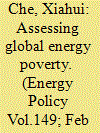

|
|
|
|
|
| Summary/Abstract |
This study makes a comprehensive assessment of global energy poverty with an integrated approach. We generate an indicator system and assign weights by rough set and a large-scale survey. Absolute ideal solutions and virtual negative ideal solutions are used to improve the Technique for Order Preference by Similarity to an Ideal Solution (TOPSIS). We further present a global assessment of energy poverty with 125 countries. The results reveal that global energy poverty improves over time. However, large spatiotemporal variations on energy poverty alleviation are found across countries. Energy availability and affordability are the major obstacles to alleviating energy poverty. Moreover, energy poverty is mostly consistent with economical levels. Developed countries have lower energy poverty than developing countries. Compared with existing methods, the proposed integrated approach can improve the accuracy of energy poverty assessment. The insights obtained from this study can help policymakers in crafting well-informed decisions and sound public policies.
|
|
|
|
|
|
|
|
|
|
|
|
|
|
|
|
| 3 |
ID:
190617
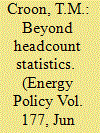

|
|
|
|
|
| Summary/Abstract |
Recent energy price spikes have led to increased energy poverty among low-income households living in inefficient homes. Accurate statistics on energy poverty help inform resource allocation and better target relief schemes and retrofit funds. Existing indicators are predominantly defined in terms of a headcount ratio – the share of population living below a certain threshold or poverty line. In this paper we draw from the literature on income poverty evaluation to argue that the use of more elaborate energy poverty gap indices can substantiate the design and monitoring of energy poverty policies, by not only considering incidence but also intensity and inequality of energy poverty across households. We demonstrate that the choice for a particular energy poverty (gap) indicator makes the implicit welfare choices of energy poverty policies explicit. We illustrate our arguments for the case of the Netherlands, using recently developed microdata statistics on energy poverty, and an imposed energy price shock. We show that spatial targeting of relief funds based on incidence would neglect the full depth of energy poverty deprivation. Finally, we argue that visualisation techniques from the income poverty literature help to comprehend different poverty orderings and draw comparisons between time periods, regions, and subgroups.
|
|
|
|
|
|
|
|
|
|
|
|
|
|
|
|
| 4 |
ID:
167033
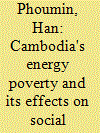

|
|
|
|
|
| Summary/Abstract |
This study aims to quantify the incidence of energy poverty in Cambodia and its potential impact on the social wellbeing of the people of Cambodia. The notion of energy poverty of a household is not well understood in the context of literature as it may refer to either ‘energy poor’ or ‘economically poor’ condition of the household. This study defines energy poverty in terms of lack of accessibility and/ or affordability of energy, which may cause the deprivation of a household and affect its wellbeing. The study uses the latest Cambodia Socio-Economic Survey Data 2015 (CSES 2015) to investigate the impacts of energy poverty on the health, education and earning opportunities of the households. The findings of the study suggest that energy poverty of a household is strongly associated with the type of fuel used and low consumption of unaffordable clean energy by the household. The resulting impacts of energy poverty on the wellbeing of households are enormous. Energy poor households have a higher probability of its members suffering from respiratory problems, spending more on medical care, having a higher dropout rate from schools and lower earning opportunities than the households without energy poverty. Based on its findings, the study suggests an urgent need of policy measures focusing on provision of clean and affordable energy to poor households to reduce / eliminate energy poverty in Cambodia.
|
|
|
|
|
|
|
|
|
|
|
|
|
|
|
|
| 5 |
ID:
101390


|
|
|
|
|
| Publication |
2011.
|
| Summary/Abstract |
In recent years successive Brazilian governments have actively pursued economic and social policies aimed at reducing poverty and promoting social equality and inclusion. In the field of energy, this has meant introducing and implementing programs aimed at expanding the supply of safe and reliable energy to the poorest sectors of Brazilian society, including those living in remote rural areas. This paper draws attention on the findings of extensive field research to evaluate the impact of rural electrification on energy poverty in the context of government policies aimed at promoting energy equity. The authors re-examine the concept of an energy poverty line, seeking to fine tune its application to Brazilian social and economic realities, and then apply an analytical framework (Lorenz Curve, Gap Poverty, Gap Quadratic, Gini Coefficient and Sen Index) to evaluate the effectiveness of recent efforts in Brazil to expand access to electricity. One of the main conclusions of this study is that is that rural electrification leads to a significant reduction of the energy poverty level and a consequent improvement in energy equity.
|
|
|
|
|
|
|
|
|
|
|
|
|
|
|
|
| 6 |
ID:
162946
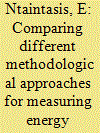

|
|
|
|
|
| Summary/Abstract |
This paper uses and comparatively evaluates objective, subjective and composite indicators for measuring and analyzing energy poverty in Attika Region, Greece. The necessary data for the quantification of these indicators were gathered through a survey involving 451 households. The results of the analysis showed that the measurement of energy poverty based on classical objective and subjective indices leads to divergent results, which in addition have little relevance to each other. To a large extent, households characterized as energy poor by one method are not classified as such with another. The use of composite indicators adjusted to local circumstances seems to form a more coherent framework for measuring energy poverty in an area and may provide additional information as regards the intensity of energy poverty. The implementation of the two composite indicators developed in the context of this study showed that energy poverty levels in the region of Attica range between 37% and 43.5%. About 27.5% of the households are energy poor with both composite indicators, while the 11.5% of households are characterized by high energy poverty intensity. Also, the analysis of the characteristics of the energy poor households provides useful insights for developing appropriate policies to tackle the problem.
|
|
|
|
|
|
|
|
|
|
|
|
|
|
|
|
| 7 |
ID:
167035
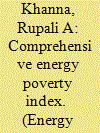

|
|
|
|
|
| Summary/Abstract |
The absence of adequate modern sources of energy impedes the presence of decent living conditions. This very lack of modern sources of energy is Energy Poverty. Lack of availability, accessibility, and affordability are the main reasons behind this problem. In the literature, all three aspects were not covered together. In this paper, we have developed a composite index of energy poverty to measure the magnitude of energy poverty in the ASEAN region and India, where we capture all three elements. The measure revealed the degree of problem in each country, with Cambodia being the most energy poor amongst the countries in the study and Thailand being the least energy poor. To dig deeper into the problem at the micro level and to deliberate the policy implications, we developed detailed village-level case studies and analysed region-specific energy poverty. We thus identify the key root causes and propose effective solutions to eradicate the prevailing problem in these regions.
|
|
|
|
|
|
|
|
|
|
|
|
|
|
|
|
| 8 |
ID:
150914


|
|
|
|
|
| Summary/Abstract |
In this article we conceptualise energy use from a capabilities perspective, informed by the work of Amartya Sen, Martha Nussbaum and others following them. Building on this, we suggest a corresponding definition of energy poverty, as understood in the capabilities space. We argue that such an understanding provides a theoretically coherent means of comprehending the relationship between energy and wellbeing, and thus conceptualising energy deprivation, that makes sense across settings including both the global North and South: a coherence which has previously been lacking. At the same time, it has the flexibility to be deployed in a way that is sensitive to local contexts. Understanding energy use in the capabilities space also provides a means for identifying multiple sites of intervention, including some areas that are currently largely overlooked. We argue that this is advantageous for attempts to address energy poverty in the context of climate change and imperatives for the containment of aggregate energy consumption.
|
|
|
|
|
|
|
|
|
|
|
|
|
|
|
|
| 9 |
ID:
166381
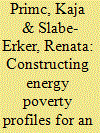

|
|
|
|
|
| Summary/Abstract |
Energy poverty is becoming ever more important for academia and policymakers. This study conducts fuzzy-set qualitative comparative analysis (fsQCA) with the aim of constructing energy poverty profiles. FsQCA was performed on 150 households. The results show that energy-poor households are characterised by the interdependence and intertwining of socio-demographic (ownership status, education level, labour force status and household size) and housing (type of building, central heating system and solar collectors/heat pump) characteristics. The conditions form eight equifinal configurations related to energy-poor households. None of the individual characteristics is able to explain energy poverty alone, although strong interrelations are present in the outcomes. The study also highlights that the conditions play different roles in the presence or absence of energy poverty, giving policymakers the necessary leeway to formulate effective policies as part of agendas covering poverty in general, poor health, climate change and domestic energy inefficiency. This study suggests that energy poverty is a structural issue, mainly arising from poor energy-efficient buildings and/or labour market inefficiencies.
|
|
|
|
|
|
|
|
|
|
|
|
|
|
|
|
| 10 |
ID:
162906
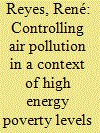

|
|
|
|
|
| Summary/Abstract |
Firewood is the main fuel used for heating in Chile, but its inefficient use is producing severe episodes of air pollution. To address this issue, authorities implement Air Pollution Management Plans (PDAs), which include actions such as setting moisture requirements for firewood, replacing old wood-stoves, temporarily banning the use of firewood, and improving homes´ thermal insulation. However, PDAs do not focus on nor do they prioritize measures in relation to specific social contexts. This study assessed socio-economic variables, energy consumption and indoor environments in households located in the city of Valdivia, through surveys and the monitoring of temperatures and indoor air pollution levels. We found that, during the winter months, 68% of the time living room temperatures were below 21 °C, and PM2.5 concentrations were above international standards. Furthermore, over 61% of households were to suffer a state of energy poverty. We urge decision-makers to consider social inequalities and energy consumption patterns in cities with high firewood consumption, prioritizing measures and focusing resources on reducing both air pollution and energy poverty. Thermal insulation of homes should be a priority in mid-to-low-income families, since these have the highest levels of energy demand. Other PDA´s measures could be economically regressive in these social-strata.
|
|
|
|
|
|
|
|
|
|
|
|
|
|
|
|
| 11 |
ID:
175246
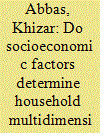

|
|
|
|
|
| Summary/Abstract |
This paper examines the socioeconomic factors of energy poverty at the household level using a dataset of 674,834 households from six South Asian countries. An adjusted multidimensional energy poverty index (MEPI) is used to measure the extent and depth of energy poverty, and a Tobit model is employed to examine the significance of socioeconomic status for multidimensional energy poverty. An ordinary least squares (OLS) regression model is compared with the results of the Tobit model, using the combined dataset and the datasets for each country separately. House size, household wealth, education, occupation (clerical, sales, or agricultural), and gender of the head of the households are significant negative socioeconomic determinants of household multidimensional energy poverty. Place of residence, house ownership status, family size, and the age of the primary breadwinner play a significant positive role in multidimensional energy poverty. These results suggest that effective policy measures for improving the socioeconomic status of households will mitigate multidimensional energy poverty. With implications for the design and implementation of policy, the evidence-based results of this study will contribute to reducing the detrimental impacts of multidimensional energy poverty nationally, regionally, and globally.
|
|
|
|
|
|
|
|
|
|
|
|
|
|
|
|
| 12 |
ID:
121388
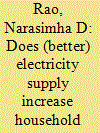

|
|
|
|
|
| Publication |
2013.
|
| Summary/Abstract |
Electricity access is an important driver of economic development. Previous studies treat electrification as a binary outcome. In reality, in developing countries households with access face chronic supply interruptions, which can last up to 12 h a day. This is the first study to estimate the income differences in urban and rural non-farm enterprises in Indian households with different levels of electricity supply, using a subset of 8125 households in the India Human and Development Survey, a cross-sectional national sample of 41,554 households. I use multiple econometric approaches, including linear regression with an instrument variable and propensity-score matching with multiple treatment levels to represent supply availability. I find a robust income effect of access, and suggestive evidence of the effect of better supply availability. The aggregate income impact across existing NFEs in India of improving supply to 16 h a day could be on the order of 0.1 percent of GDP.
|
|
|
|
|
|
|
|
|
|
|
|
|
|
|
|
| 13 |
ID:
185712
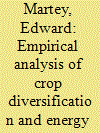

|
|
|
|
|
| Summary/Abstract |
Despite the importance of energy in countries' economies, the vast majority of people, especially in developing countries, live under the energy poverty line. To mitigate this trend, several policy options have been enacted to promote the use of clean and modern fuels given the targets set out in the Sustainable Development Goal Two (SDG2). However, there is a lack of systematic empirical evidence on how crop diversification can alleviate energy poverty in developing countries. This study used the seventh round of the Ghana Living Standard Survey (GLSS 7) to test the effect of crop diversification on the multidimensional energy poverty index (MEPI). I employ the instrumental variable (IV) and the Lewbel two stage least squares (2SLS) techniques and perform several robustness checks to address the potential endogeneity in crop choices. The estimates show that crop diversification is associated with a 0.829 standard deviation decreases in household energy poverty. The effect is prominent for urban and high-income earning households. Household income is identified as the main potential channel through which crop diversification influences energy poverty.
|
|
|
|
|
|
|
|
|
|
|
|
|
|
|
|
| 14 |
ID:
191415
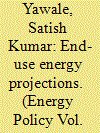

|
|
|
|
|
| Summary/Abstract |
Regional disparity and energy poverty are major challenges for India on a macro-scale. In this study we explored regional disparity and energy poverty in India's future by formulating a series of unique mathematical functions while analyzing historical time-series of per-capita energy consumption (PEC). The functions formulated have important implications on India's approaches towards rapid urbanization, access to clean energy, and rural electrification. We also analyzed end-use energy consumption in low, mid and high-developing states and examined the impacts of the uncertainty of socio-economic changes. As per our estimates, energy consumption in urban areas, is likely to grow by 3.6 times from 2010 to 2070, whereas that in rural areas is likely to decrease by 0.6 times. Energy poverty among Indian states narrows by 2050, while energy consumption in the mid and high-developing states rises rapidly as urbanization and per-capita income increase. Even with this consumption growth, India's average household PEC in 2070 may remain lower than the world average recorded in 2010. The provision of advanced energy resources and technologies is therefore likely to be an important policy challenge for India, especially in the rural areas of low-developing states, as the country pursues its target of reducing energy poverty and regional disparity.
|
|
|
|
|
|
|
|
|
|
|
|
|
|
|
|
| 15 |
ID:
169724
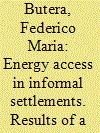

|
|
|
|
|
| Summary/Abstract |
This paper presents the results of a survey on two informal settlements in Rio De Janeiro: Reta Velha (Itaboraí) and Jardim Bom Retiro (São Gonçalo). A detailed analysis of energy access and energy poverty level has been accomplished by questionnaires carried out in 400 households. The questionnaire was based on a detailed multi-tier approach. It was aimed at exploring the actual energy access and energy poverty in favelas, in addition to draw the local living conditions and the availability of the basic services. The outcomes of the research underline the problem of outages and low tension, and illegal connections. Furthermore, electricity consumption is very high compared to the service provided, and expenditures are generally disproportioned to the households’ income. Many interesting outcomes emerge from the survey. Referring to energy poverty, it is a status in which 50% of households are in Jardim Bom Retiro and 20% in Reta Velha. Due to the representativeness of the treated case, the results permit the definition of the state of the art and of enhancing guidelines suitable also for other contexts, at least in the universe of informal settlements in Latin America and Caribbean.
|
|
|
|
|
|
|
|
|
|
|
|
|
|
|
|
| 16 |
ID:
193732
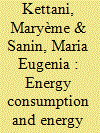

|
|
|
|
|
| Summary/Abstract |
Most of the world's increase in energy demand will come from the global south where there is the need to improve living standards while succeeding the energy transition. Herein we first study determinants of energy expenditure by source as well as energy poverty in Morocco. We find that socioeconomic determinants of energy consumption are in line with the literature on developed countries but, instead, elasticity magnitudes are generally higher, in line with the literature on low-income-countries. We also find that inequalities have an important impact on demand patterns: income elasticities are higher for households that consume the most for the case of electricity while the opposite happens with other forms of energy commonly used by low-income households. Regarding affordability, our results suggest that 14% of Moroccan households are energy poor. Energy poverty households usually are large families living in rural areas that are headed by inactive men with no education. We then measure the energy poverty gap per income quintile and asses to which extent fading-out subsidies for households for which PV panels are competitive could free resources that could be recycled to fill the energy poverty gap. In this regard we find that, if subsidies are dismantled for households for which PV panels are competitive when exposed to the natural price, the government would free 25% of the budget needed as a transfer to bridge the electricity poverty gap for the poor.
|
|
|
|
|
|
|
|
|
|
|
|
|
|
|
|
| 17 |
ID:
162947
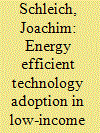

|
|
|
|
|
| Summary/Abstract |
This paper studies the adoption of high-cost, medium-cost, and low-cost energy efficient technologies (EETs) by income categories in eight European Union countries, relying on demographically representative household surveys carried out simultaneously among about 15,000 households in France, Germany, Italy, Poland, Romania, Spain, Sweden, and the United Kingdom. The statistical-econometric analyses allow the effects of income to differ by income quartiles in each country. For high cost EETs such as retrofit measures, the findings suggest that homeowners falling into the lowest income quartile exhibit lower adoption propensities than those falling into the highest income quartile. These findings provide some support for policies targeting “poor homeowners”, particularly in lower-income countries with a high share of owner-occupiers such as Poland and Romania. Further, differences in adoption propensities across income quartiles also exist for medium- and low-cost EETs such as appliances and light bulbs. Finally, analyzing factors related to homeowners receiving financial support for retrofit measures from governments or utilities suggests that differences in implementation rates between the highest and lowest income quartile would likely have been higher without such support schemes in place. For the United Kingdom (but not for other countries) these schemes appeared to have had a progressive effect.
|
|
|
|
|
|
|
|
|
|
|
|
|
|
|
|
| 18 |
ID:
176753


|
|
|
|
|
| Summary/Abstract |
After reviewing the energy policies in the Canary Islands, this study addresses the concept of energy poverty from a different perspective than that usually found in the academic literature. This analysis advances knowledge of the role played by the following six pillars: sustainability, renewable energies, energy efficiency, self-consumption regimes, electrification of energy demand and electrical interconnections, regarding energy poverty in these isolated environments. The relationship of these pillars with energy poverty is analysed in terms of energy scenarios projected for 2030. The results show that the interrelations between these six elements are a good indicator of the evolution of energy poverty. They also provide a roadmap for energy policy in these regions. This research highlights the importance of promoting energy policies that are not based on short-term results, and that energy strategy does not necessarily require planning more tasks in a shorter time. Intending to asses policies suitable for implementation in the medium and long term, this study proposes alternative definitions to measure energy poverty, by identifying the key pillars in energy planning for the Canary Islands.
|
|
|
|
|
|
|
|
|
|
|
|
|
|
|
|
| 19 |
ID:
133228
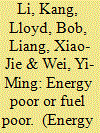

|
|
|
|
|
| Publication |
2014.
|
| Summary/Abstract |
Energy poverty and fuel poverty are descriptors of problems of households' energy consumption, they are both distinct problems and have been addressed by many researchers, organizations and governments. Cross use of the terms of energy poverty and fuel poverty in published papers is common. As an accurate descriptor is the presupposition of research and policy development, especially for those who just started to pay attention to this issue, this paper compares the definitions, research priorities, status quo, and problems of these two concepts, and summarizes the relationship between them. The paper suggests that only when the research targets are households who are living in a cold climate and have difficulty in getting access to electricity or modern cooking facilities, and in supplying indoor heating with appropriate cost, the concepts of energy poverty and fuel poverty have the chance to be broadened and mutually integrated.
|
|
|
|
|
|
|
|
|
|
|
|
|
|
|
|
| 20 |
ID:
147303
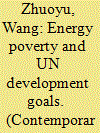

|
|
|
|
|
| Summary/Abstract |
The importance of energy has been rooted in every aspect of human life. If we have no access to electricity and depend on traditional biomass fuels to meet household energy demands, it will mean we cannot enjoy the modern energy service. With the deepening international understanding of the issue, many countries have been promoting the practice of eliminating energy poverty, and the “universal access to affordable, clean and sustainable energy” has become one of the post 2015 UN development goals.
|
|
|
|
|
|
|
|
|
|
|
|
|
|
|
|
|
|
|
|
|